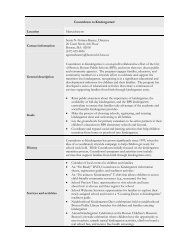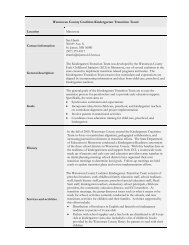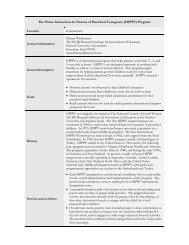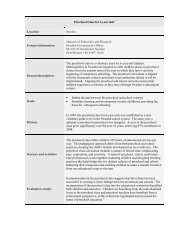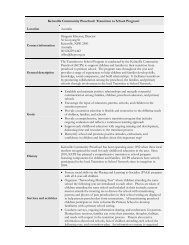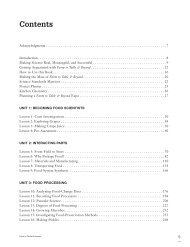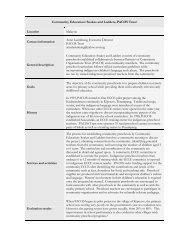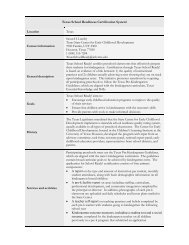Proceedings of the Fourth Annual Teachers College Educational ...
Proceedings of the Fourth Annual Teachers College Educational ...
Proceedings of the Fourth Annual Teachers College Educational ...
Create successful ePaper yourself
Turn your PDF publications into a flip-book with our unique Google optimized e-Paper software.
Although it has been hinted at throughout different eras, under <strong>the</strong> guise <strong>of</strong> Activity Theory and<br />
Social Learning Theory, Connectivism was coined as “<strong>the</strong> learning <strong>the</strong>ory for <strong>the</strong> digital age” by<br />
George Siemens and Stephen Downes (2004). Siemens and Downes have developed distinct<br />
principles, which imply connectivisms’ relevance to modern students. Connectivism is founded on<br />
individual ideas and opinions, valuing diversity in <strong>the</strong> perspectives <strong>of</strong> o<strong>the</strong>rs, lifelong learning,<br />
building relationships, interdisciplinary connections, current information, and risk taking (Siemens,<br />
2004). These same principles can be found in many current technologies that students use daily<br />
such as Facebook, Diigo, Wikis, YouTube, etc. In order for online learning to be successful and<br />
meaningful it must provide students with more than <strong>the</strong> transmission <strong>of</strong> data. New online<br />
environments must <strong>of</strong>fer students <strong>the</strong> opportunity to become a participant and creator much like<br />
<strong>the</strong>y are used to doing in everyday life.<br />
Online Learning as a Dissociative Process<br />
Central to <strong>the</strong> debate is <strong>the</strong> concept that “educational technology participates in <strong>the</strong> cultural<br />
context and is as much a part <strong>of</strong> <strong>the</strong> learning problem to be identified as it is <strong>of</strong> <strong>the</strong> solutions<br />
implemented” (Belisle, 2001, p. 25). Saugstad (2002), when examining <strong>the</strong> work <strong>of</strong> Aristotle,<br />
suggested that knowledge is primarily seen as a product ra<strong>the</strong>r than a competence which<br />
suggests human activity (p. 378). This suggestion contributes to a critical view <strong>of</strong> <strong>the</strong> relevance <strong>of</strong><br />
current online educational systems. Separating <strong>the</strong> person from <strong>the</strong> product does not contribute<br />
to learning. It also suggests that online learning in higher education, in its current state, does not<br />
sufficiently provide students with engaging and rigorous material in preparation for pr<strong>of</strong>essional<br />
careers. Belisle (2001) suggests that this perspective <strong>of</strong> learning is flat and focused on learning<br />
as opposed to teaching (p. 15). Hamilton (2004) refers to <strong>the</strong> delivery <strong>of</strong> knowledge style systems<br />
as fast knowledge or ‘McKnowledge’ (p. 844).<br />
Critics <strong>of</strong> online education argue that virtual environments are not able to provide students with<br />
<strong>the</strong> same quality and caliber <strong>of</strong> education that traditional, face-to-face courses can. They also<br />
suggested that online environments expect too much from students in terms <strong>of</strong> self-discipline and<br />
this expectation can lead new students and students unfamiliar with online education to failure<br />
(Bejenaro, 2008, p.412). It is easy for students to become isolated and completely independent in<br />
online course without <strong>the</strong> facilitation <strong>of</strong> <strong>the</strong> instructor/ Instructors should provide students with<br />
“corrective feedback, encouragement, and motivation” to ensure success in learning (Young,<br />
2006, p. 73).<br />
References<br />
Bejerano, A. R. (2008). The Genesis and Evolution <strong>of</strong> Online Degree Programs: Who are <strong>the</strong>y for<br />
and what have we lost along <strong>the</strong> way?. Communication Education, 57(3), 408-414.<br />
Belisle, C., Rawlings, A. & Van Seventer, C. (2001) The educational multimedia taskforce<br />
1995-2001: Integrated research effort on multimedia education and training.<br />
Luxembourg: European Commission. Retrieved from: http://www.cordis.lu/ist/ka3/<br />
eat/training_publ.htm.<br />
Green, N. C., Edwards, H., Wolodko, B., Stewart, C., Brooks, M., & Littledyke, R. (2010).<br />
Reconceptualising higher education pedagogy in online learning. Distance Education,<br />
31(3), 257-273.<br />
Hamilton, D., Dahigren, E., Hult, A., Roos, B., & Söderström, T. (2004). When performance is <strong>the</strong><br />
product: problems in <strong>the</strong> analysis <strong>of</strong> online distance education. British <strong>Educational</strong><br />
Research Journal, 30(6), 842-855.<br />
Hoskins, B. (2011). Demand, growth, and evolution. Journal <strong>of</strong> Continuing Higher Education,<br />
59(1), 57-60.<br />
Rheingold, H. (2010, September/October). Attention and o<strong>the</strong>r 21st century social media<br />
literacies. Educause Review, 45(5), 14-24.<br />
Siemens, G. (2004). Connectivism: A learning <strong>the</strong>ory for <strong>the</strong> digital age. International Journal<br />
<strong>of</strong> Instructional Technology and Distance Learning. Retrieved from<br />
http://www.elearnspace.org/Articles/connectivism.htm<br />
Young, S. (2006). Student views <strong>of</strong> effective online teaching in higher education. American<br />
Journal <strong>of</strong> Distance Education, 20(2), 65-77.<br />
53



